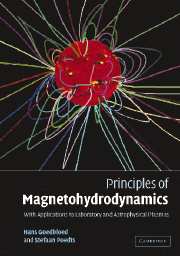Book contents
- Frontmatter
- Contents
- Preface
- Part I Plasma physics preliminaries
- Part II Basic magnetohydrodynamics
- 4 The MHD model
- 5 Waves and characteristics
- 6 Spectral theory
- 7 Waves and instabilities of inhomogeneous plasmas
- 8 Magnetic structures and dynamics
- 9 Cylindrical plasmas
- 10 Initial value problem and wave damping
- 11 Resonant absorption and wave heating
- Appendices
- References
- Index
4 - The MHD model
Published online by Cambridge University Press: 22 February 2010
- Frontmatter
- Contents
- Preface
- Part I Plasma physics preliminaries
- Part II Basic magnetohydrodynamics
- 4 The MHD model
- 5 Waves and characteristics
- 6 Spectral theory
- 7 Waves and instabilities of inhomogeneous plasmas
- 8 Magnetic structures and dynamics
- 9 Cylindrical plasmas
- 10 Initial value problem and wave damping
- 11 Resonant absorption and wave heating
- Appendices
- References
- Index
Summary
The ideal MHD equations
The dynamics of magnetically confined plasmas, as exploited in laboratory nuclear fusion research and observed in astrophysical systems, is essentially of a macroscopic nature so that it can be studied in the fluid (MHD) model introduced in Chapter 2. The ‘derivation’ of the MHD equations in Chapter 3 provided indications about the range of validity and the limitations of the equations. In the present chapter, we will develop the MHD model for the interaction of plasma and magnetic field in detail and, thus, obtain a powerful ‘picture’ for the dynamics of the mentioned plasmas.
Recall from the introduction of Chapter 3 that the equations of magnetohydrodynamics can be introduced either by just posing them as postulates for a hypothetical medium called ‘plasma’ or by the much more involved procedure of averaging the kinetic equations. Whereas Chapter 3 was mainly concerned with the second method, in the present chapter we exploit the first method: we simply pose the equations and use physical arguments and mathematical criteria to justify the result. We continue the exposition of Section 2.4.1, where we already encountered the relevant equations.
Postulating the basic equations
The ideal MHD equations describe the motion of a perfectly conducting fluid interacting with a magnetic field. Hence, we need to combine Maxwell's equations with the equations of gas dynamics and provide equations describing the interaction.
First, consider Maxwell–s equations, already encountered in Chapters 2 and 3.
- Type
- Chapter
- Information
- Principles of MagnetohydrodynamicsWith Applications to Laboratory and Astrophysical Plasmas, pp. 131 - 185Publisher: Cambridge University PressPrint publication year: 2004



